Today, instead of 'art about science' I bring you 'science about art', if you will.
"Using real footage and sounds from a working science lab, the Inside Knowledge team have reconstructed the White Stripes song Seven Nation Army from scratch."
The equipment is from Imperial College's BLAST lab; like its name suggest, the scientists at the lab study the effects of explosions, specifically "the behaviour of the human skeleton under high impulse loading" from an inter-disciplinary perspective involving medicine, physics, bioengineering, and military research. You can imagine how the machinery might inspire a percussionist. The Inside Knowledge team consists of four science communication students who are interested in the scientific process, not just the sort of headline-grabbing results released at press conferences. They say they want to produce a unique multimedia diary of their time 'embedded' at the BLAST lab. I'm really impressed; this may not be what we think of as 'science communication' but the video did effectively give me a glimpse of what they actually do in the lab, piqued my interest and entertained me - all of which is far to rare in much of the scientific journalism out there.
(via Toronto Standard)
Wednesday, February 22, 2012
Tuesday, February 21, 2012
Whale Fall
Whale Fall (after life of a whale) from Sharon Shattuck on Vimeo.
Directed by Sharon Shattuck and Flora Lichtman for Sweet Fern Productions.
This beautiful short film (paper puppetry, by the way, not stop-motion) details the after-life of a whale. I don't mean it's about the ghost of a whale; I mean it details quite literally the life supported for decades, by the deceased body of a whale. The choices made in terms of medium (paper) and music, help emphasize the wonder of the ecology, the diversity of life supported, and avoids the sort of bias we may have that the subject matter is somehow gruesome, rather than the most natural thing. I love the idea of paper puppets employed in, essentially, a short of science documentary.
Sharon Shattuck describes herself as a "director-animator and botanist", so it makes sense that she would make art about science. (via Bioephemera)
I am familiar with several of these critters from research cruises where we've employed remotely operated submersibles. The rattails are always the most common thing we see on the seafloor.
If you are interested in the ecological afterlife of animals which fall to the seafloor, you can check out, for instance, the VENUS pig experiment, where a dead pig was placed on the seafloor and monitored with a cabled seafloor observatory, offshore Vancouver Island.
Thursday, February 16, 2012
Periodic Table
The place where scientific pun meets typography meets furniture design is surprisingly lovely. A scientific toy company, Thames and Kosmos needed a conference table and put forward the clever idea that they clearly needed a Periodic Table, of the elements. The table was designed by Jackson Morley with type design and hand painting by Josie Morway. She writes, "It's 16 whopping feet long and features a large slice of the periodic table, each element hand painted (and jubilantly, by me) in a different typeface."
4/4" maple top with steel support structure. 192" x 42".
Fabricated by Jackson Morley using shop time at Keeseh Studio and the Steel Yard.
I want to know if the nature of the elements dictated the typeface designed.
Be sure to check out Josie's portfolio for beautifully painted animals and original type design. You can also find her at fruitful harm.
4/4" maple top with steel support structure. 192" x 42".
Fabricated by Jackson Morley using shop time at Keeseh Studio and the Steel Yard.
I want to know if the nature of the elements dictated the typeface designed.
Be sure to check out Josie's portfolio for beautifully painted animals and original type design. You can also find her at fruitful harm.
Tuesday, February 7, 2012
Jellyfish Chandelier
Lately, I've been all about bioluminescent comb jellies, so discovering the work of Czech student (!) Kateřina Smolíková I was immediately struck. She isn't the first to find inspiration for lighting in the diaphonous and often luminous beauties of the deep, but her Skyphos chandelier is so crisp and modern, it's like nothing else I've seen.
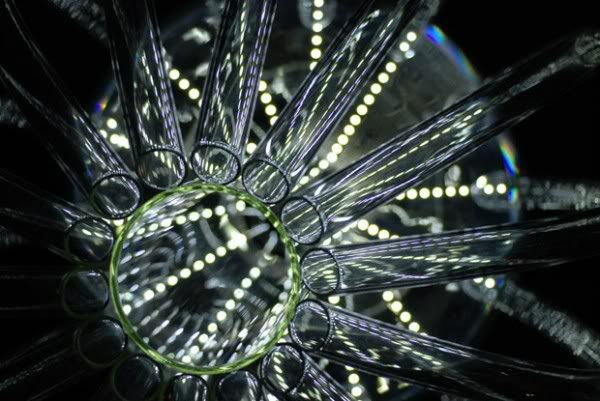
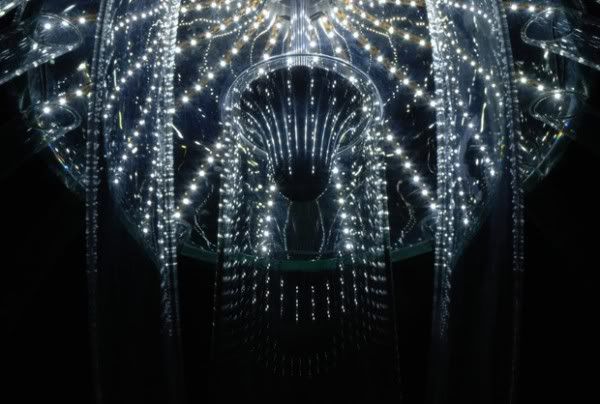


There is plenty to explore in her portfolio (via architizer).
If you prefer your jellyfish lighting with more fluid, organic and flexible lines, check out these plastic discomedusa lights by Roxy Towry-Russell:

French sculptor Géraldine Gonzalez has some really beautiful medusas too, some of which involve crystals and LEDs and others of paper.


Do not forget the anotomically correct and beautifully rococo glass work of the previously-blogged Timothy Horn.




There is plenty to explore in her portfolio (via architizer).
If you prefer your jellyfish lighting with more fluid, organic and flexible lines, check out these plastic discomedusa lights by Roxy Towry-Russell:

French sculptor Géraldine Gonzalez has some really beautiful medusas too, some of which involve crystals and LEDs and others of paper.


Do not forget the anotomically correct and beautifully rococo glass work of the previously-blogged Timothy Horn.
Thursday, February 2, 2012
Happy Groundhog Day!

Well, it's that time of year again, midway between Solstice and Equinox, when we turn to the weather prognosticating rodents to assess of chances of better weather. Since this part of Ontario has been spared much winter at all, it may not surprise you to learn that Wiarton Willie (technically, Wee Willie, as the original, or at least, most recent albino Wiaton Willie is desceased) and his Nova Scotia cohort Shubenacadie Sam both did not see their shadows this morning. If you believe the (wildly inaccurate*) weather prognostication of rodents, readers south of the border may be dismayed that Pennsylvania’s Punxsutawney Phil disagrees, having observed his own shadow. However, this year, thanks to the positive phase of the Arctic Oscillation much of North America has had low snow cover and warmer-than-average temperatures. So, for once, I think that there has not been much winter to speak of, and the Canadian groundhogs may actually be right.
The photo, of course, is of two copies of my a groundhog and his thermochromic shadow linocut - on Japanese kozo paper 11" by 12.5" (28 cm by 31.8 cm). The shadow on the left has been heated, and thus it disappeared. So the print itself serves as a prognosticating groundhog for Groundhog Day! If the shadow is heated above 30°C (86 F) then it turns colourless. And let's face it; if it's February 2, and your artwork is > 30°C (86 F) you either a) live in the tropics north of the equator b) live in the Southern Hemisphere or c) need to turn the thermostat down ASAP. So, there's a pretty good chance that this print can accurately predict that there will not be 6 more weeks of winter (to a degree of accuracy at least comparable to any celebrity rodent).
*Estimated at 37% accuracy
(x-posted to the on-going saga of minouette blog)
Wednesday, February 1, 2012
Quilling Anatomy
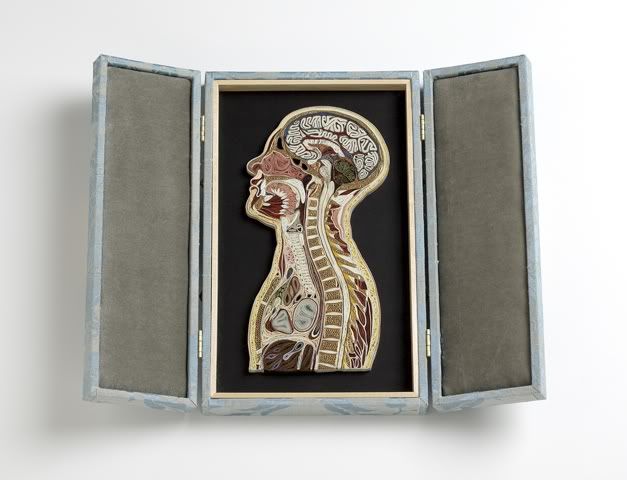
Head and Torso
2010
mulberry paper
9 x 13 x 1 inches
Artist Lisa Nilsson combines the Mideval art of paper quilling and modern antomical science in her incredibly detailed (and accurate) assemblages. Using long strips of Japanese kozo, or mulberry paper, and strips of gilded book pages, she uses a variety of tools to curl pages into the right shapes to represent all the tissues in our bodies. I know that kozo is wonderfully strong, but it also comes in a large variety of colours, which makes it a versitile medium. She says she was inspired to start using quilling as a technique after finding a reliquary; the earliest quiller were nuns who started using the gilded edges of bibles as a creative medium.
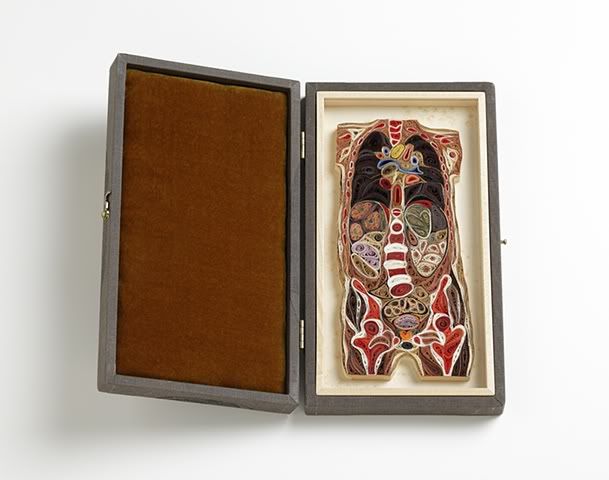
Female Torso
2010
paper
9 x 10 x 3/4 inches
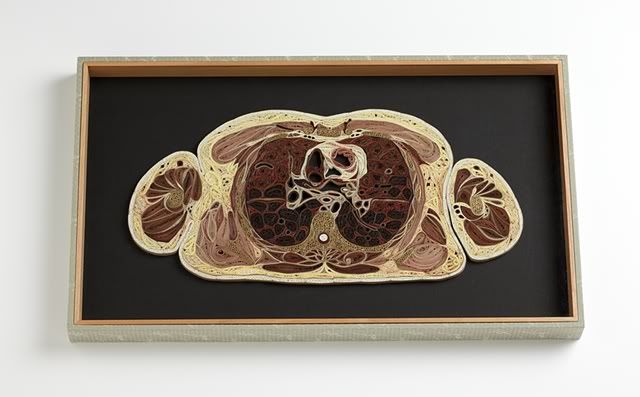
Thorax
2011
paper
21 1/2 x 12 1/2 x 1 1/2 inches
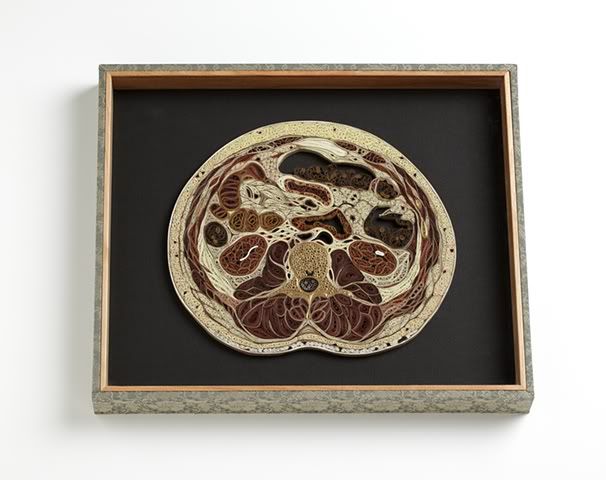
Abdomen
2011
paper
15 x 12 1/2 x 1 1/2 inches
The detailed photos give you a sense of the meticulous work involved.
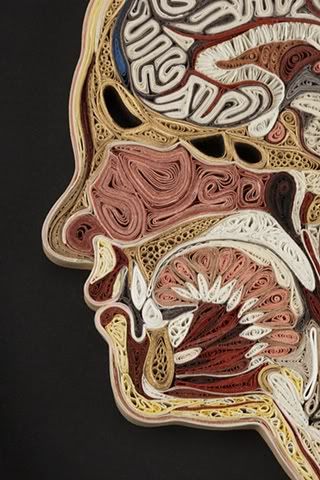
Profile (detail)
2011
paper
A detail of "Profile" showing the sinuses, front teeth and tongue.

Head II (detail)
2011
A detail of "Head II" showing a cross section of the brain.
She explains that she uses gilded paper to tie her work to religious reliquaries and a little less to scientific specimen, but I cannot help but see this work also as beautiful and creative medical illustration.
Be sure to check out her other work in her portfolio.
Also, for another take on quilling human anatomy, check out the work of Sarah Yakawonis.
(via Craft, all things paper and artsake)
Subscribe to:
Posts (Atom)








